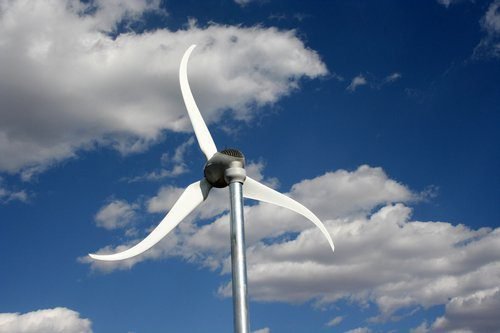Last Updated on February 26, 2023 by
A wind turbine is a device that converts the energy of wind into electricity. Wind turbines are usually built in groups, or “farms,” of many devices to maximize the efficiency of electricity production. How do wind turbines work? The blades of a turbine are turned by the wind, which in turn powers a generator that produces electricity. The amount of electricity produced by a turbine depends on the speed of the wind, the size of the turbine, and the efficiency of the generator. Most turbines have three blades, although there are also some with two or four blades. The blades are connected to a shaft in the center of the turbine, and as they turn, they spin the shaft. This action activates a generator, which then produces electricity. The electricity produced by the turbine is sent through power lines to homes and businesses.
Wind turbines can be used to power individual homes or small businesses, but they are most commonly used in large-scale operations such as farms or industrial complexes. When used in large operations, many turbines are connected to form a “wind farm.” The electricity produced by these farms is then sent to a power grid, where it can be used by anyone who needs it.
Wind energy is a clean and renewable resource that can be used to generate electricity without producing pollution or greenhouse gases. Wind turbines are an important part of our effort to create a clean and sustainable energy future.
Table of Contents
How to choose the right wind turbine for your home
When it comes to generating your own electricity from the wind, there are a few things to consider before selecting a turbine. The size and location of your home, the average wind speed in your area, and local zoning regulations will all play a role in choosing the right turbine. First, you’ll need to determine the average wind speed at your home using an anemometer. This will help you choose a turbine with the right amount of power for your needs. Next, you’ll need to consider the height and placement of the turbine. Ideally, it should be placed in an open area with few obstacles that can block the wind. Finally, check with your local zoning office to make sure there are no regulations that would prevent you from installing a turbine. With these factors in mind, you’ll be well on your way to choosing the right turbine for your home.
The benefits of having a wind turbine for your home
As more and more people look for ways to reduce their carbon footprint, wind turbines have become an increasingly popular option for generating energy at home. While the initial cost of installing a turbine may be higher than other methods of energy production, the long-term benefits make it a wise investment. Wind turbines can provide a virtually endless supply of clean, renewable energy, which can save money on energy bills and help to reduce reliance on fossil fuels. In addition, wind turbines can increase property value and provide an aesthetic appeal. With so many benefits, it’s no wonder that wind turbines are becoming an increasingly popular choice for power generation.
Read more: What does DDoS Protection Mean? How to Buy a VPS?
How to install a wind turbine for your home
If you’re interested in installing a wind turbine, the first step is to do your research. There are many different types and sizes of turbines available, and you’ll need to choose the one that best suits your needs. Once you’ve selected a turbine, the next step is to install it. The process will vary depending on the type of turbine you’ve chosen, but most turbines can be installed in a few hours with basic tools. Once your turbine is up and running, you’ll be able to start generating power for your home. With a little bit of planning and effort, you can easily install a wind turbine and start enjoying the benefits of renewable energy.
Read More: How Does Ip Filtering Protect Your Business From Cybercriminals?
Maintenance and troubleshooting tips for wind turbines
Wind turbines are an increasingly popular source of renewable energy, but they require regular maintenance to keep them running smoothly. Here are some tips for troubleshooting and maintaining wind turbines:
First, check the blades for damage. If there are any cracks or splits, they will need to be repaired or replaced. Also, make sure that the blades are properly attached to the turbine. Loose blades can cause the turbine to vibrate and can eventually lead to damage.
Second, check the tower for damage. If the tower is leaning, it needs to be repaired or replaced. Also, check for rust or other damage on the tower. This can weaken the structure and cause it to collapse.
Third, check the bearings for wear. Bearings that are worn out will cause the turbine to vibrate and can eventually lead to damage. Replacement bearings can be found at most hardware stores.
Fourth, check the generator for problems. If the generator is not working properly, it will need to be repaired or replaced.
Finally, check the wiring for damage. Damaged wires can cause sparks and fires. If you find any damaged wires, they will need to be replaced immediately.
Read More: How to Find Serial Number for Printed Circuit Boards?













